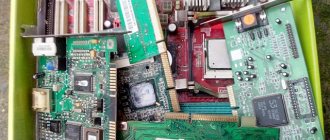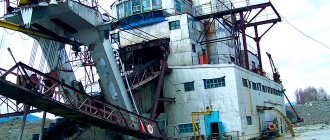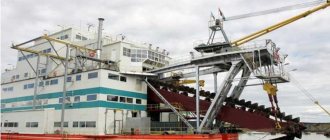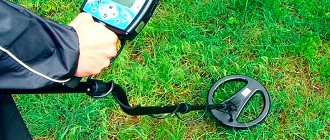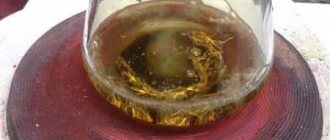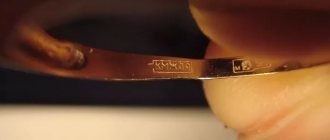How to make a gateway for gold mining with your own hands
This article was born in connection with the increased interest in gold mining. I often get asked questions about how to get gold from streams and rivers? How to make a gateway for gold mining with your own hands? Where and what kind of gateway should I buy? How to make a passage with your own hands?
In this article I will tell you how to make a gateway with your own hands. The equipment is so simple that anyone can make it in a couple of hours at home and in many respects it will be better than a purchased American aluminum gateway, the cost of which in Russia reaches 17,000 rubles.
I’ll tell you how to properly make a gold-catching sluice, a mini device for gold mining, popularly called a prodnushka. This is what the prospectors of Siberia and the Urals call it, the name that came to us from our grandfathers and great-grandfathers is prodnushka.
A passage (sluice) is a box made of three boards, at the bottom of which a mat is laid and a stencil (riffle) is placed. A walk-through made of wood is not only simpler and cheaper than one made of aluminum, but most importantly, if something happens, you won’t mind throwing it away. If you use dry and not thick wood, then the weight will be no more than that of an aluminum analogue, and with a skillful approach, even less. In addition, wooden boards in your car or backpack will not raise questions from strangers; no one will ask what kind of boards they are or ask unnecessary questions. You never know what purpose you need these boards for in the forest.
To make a passage (sluice) for gold mining, the main thing is to follow the basic simple rules in its manufacture, and you will be a more successful gold miner than other prospectors with short purchased sluices.
The longer the hole, the more gold you will catch. Foreign aluminum sluices have a maximum length of 1.5 meters; this is not enough to catch fine gold and disintegrate poorly washed sands or loams. The length of foreign locks is 1.5 meters due to legislation that limits the length of the lock, so that amateur tourists do not wash out all the gold on the stream and leave it to others. For example, in America, Australia, and New Zealand, gold mining is a hobby, like picking mushrooms or fishing in our country.
The width of the sluice depends on the amount of rock supplied; for bucket feeding, a width of 20-25 cm is sufficient.
To make a long and easy-to-carry passage, use a cascade of gateways, for example, install two gateways of 1.5 meters in series, for a total of 3 meters. This is sufficient to trap fine gold and disintegrate the rock.
If the soil is clayey and does not have time to be washed through the passage, you need to use other equipment called butara. I will talk about it in the following articles or videos on my channel www.youtube.com/user/RudolfKavchik
Installation of riffles or as they are also called stencils.
The stencil is the most important part of the pass-through. Behind them, a turbulence of the water flow and its rarefaction occurs. This creates conditions for the accumulation of the heavy fraction behind the riffle plates and the demolition of light unnecessary material. The angle of inclination of the riffle plates depends on the amount of water supplied to the passage and can be from 45 to 78 degrees. The greater the depth of the flow and the speed of the flow of water supplied to the sluice, the greater the angle of inclination of the riffles. The distance between the riffles is 5-7 cm. The shape of the riffles can be straight or with slightly curved edges in the direction of flow.
If the water flow is weak, then riffles are not used. The rock is sifted through a sieve before being fed to the mini device. See the chapter on material screening below.
The next chapter is about a gold catching mat and what to make a gold catching mat from. How to install a passage, sieve and screen for gold-bearing rock. From the history of gold mining - is there a need for a mat on the sluice?
How to make a sluice for gold washing with your own hands. Part 1.
This article was born in connection with the increased interest in gold mining.
I often get asked questions about how to get gold from streams and rivers? How to make a gateway for gold mining with your own hands? Where and what kind of gateway should I buy? How to make a passage with your own hands? In this article I will tell you how to make a gateway with your own hands. The equipment is so simple that anyone can make it in a couple of hours at home and in many respects it will be better than a purchased American aluminum gateway, the cost of which in Russia reaches 17,000 rubles.
I’ll tell you how to properly make a gold-catching sluice, a mini device for gold mining, popularly called a prodnushka. This is what the prospectors of Siberia and the Urals call it, the name that came to us from our grandfathers and great-grandfathers is prodnushka.
A passage (sluice) is a box made of three boards, at the bottom of which a mat is laid and a stencil (riffle) is placed. A walk-through made of wood is not only simpler and cheaper than one made of aluminum, but most importantly, if something happens, you won’t mind throwing it away. If you use dry and not thick wood, then the weight will be no more than that of an aluminum analogue, and with a skillful approach, even less. In addition, wooden boards in your car or backpack will not raise questions from strangers; no one will ask what kind of boards they are or ask unnecessary questions. You never know what purpose you need these boards for in the forest.
To make a passage (sluice) for gold mining, the main thing is to follow the basic simple rules in its manufacture, and you will be a more successful gold miner than other prospectors with short purchased sluices.
Gateway length.
The longer the hole, the more gold you will catch. Foreign aluminum sluices have a maximum length of 1.5 meters; this is not enough to catch fine gold and disintegrate poorly washed sands or loams. The length of foreign locks is 1.5 meters due to legislation that limits the length of the lock, so that amateur tourists do not wash out all the gold on the stream and leave it to others. For example, in America, Australia, and New Zealand, gold mining is a hobby, like picking mushrooms or fishing in our country.
The width of the sluice depends on the amount of rock supplied; for bucket feeding, a width of 20-25 cm is sufficient.
To make a long and easy-to-carry passage, use a cascade of gateways, for example, install two gateways of 1.5 meters in series, for a total of 3 meters. This is sufficient to trap fine gold and disintegrate the rock.
If the soil is clayey and does not have time to be washed through the passage, you need to use other equipment called butara. I will talk about it in the following articles or videos on my channel https://www.youtube.com/user/RudolfKavchik
Installation of riffles or as they are also called stencils.
The stencil is the most important part of the pass-through. Behind them, a turbulence of the water flow and its rarefaction occurs. This creates conditions for the accumulation of the heavy fraction behind the riffle plates and the demolition of light unnecessary material. The angle of inclination of the riffle plates depends on the amount of water supplied to the passage and can be from 45 to 78 degrees. The greater the depth of the flow and the speed of the flow of water supplied to the sluice, the greater the angle of inclination of the riffles. The distance between the riffles is 5-7 cm. The shape of the riffles can be straight or with slightly curved edges in the direction of flow.
If the water flow is weak, then riffles are not used. The rock is sifted through a sieve before being fed to the mini device. See the chapter on material screening below.
Gold catching mat.
A gold catching mat can be made from any natural fabric, such as burlap, tarpaulin, and even an ordinary waffle towel that housewives use in the kitchen will do. The main purpose of the mat is to ensure that the riffles adhere to the bottom of the sluice so that the accumulated material is not washed away by the leaking flow under the riffles.
Industrial enterprises use cellular gold-collecting mats. This is due to the technological process of gold mining. The rock is transported to the industrial equipment by multi-ton Belaz trucks, washing thousands of cubic meters of gold-bearing rock per day. Each Belaz truck contains ten grams of gold, which is brought in for washing every few minutes. It is not profitable for the enterprise to stop the washing process to unload the industrial equipment; this will require stopping production for 2-3 hours, and time is gold, in the literal sense of the word. The industrial device is unloaded once a day. Due to the large amount of washed rock, there was a need for cellular mats with a high profile, which accumulate heavy metal and prevent it from being carried away by the flow of water, which increases the time of effective operation of the industrial device.
At its core, a honeycomb mat works like a stencil/reel. In the depths of the cells, vortex flows are created that carry away light particles of sand, leaving heavy metals at the bottom: gold, platinum.
You don’t have to use a cellular mat in the passageway, since the rock for washing is not supplied by dump trucks, and gold can be easily removed at any time as heavy material accumulates. In addition, a cellular mining mat is not easy to obtain and its cost of several thousand rubles is not at all justified when used on mini devices.
You can make an analogue of a cellular mat yourself from an ordinary household cellular mat, which many people have on their porch and is sold in every hardware store under the name “anti-slip coating.” The mesh size of the anti-slip coating is approximately 5 mm. See photo.
The anti-slip coating is laid on top of the rag mat. Ribbons are installed on top. Such a system will work no worse than an industrial rug, it’s easier to buy, and its cost is much lower, and if something happens, you won’t mind throwing it away.
Author Rudolf Kavchik, Irkutsk
Photo by Rudolf Kavczyk
How to make a gateway for gold mining with your own hands. To avoid buying.
Video on how to use the pass-through. Also, you will learn what raft, peat and gold-bearing rock are - sand or layer.
Spare parts for dredger ZGM-2M
The ZGM-2M horizontal single-stage centrifugal cantilever type dredge pump, with a one-way entry impeller, is designed for pumping and transporting abrasive pulp, eroded rock to industrial devices during the development of various deposits, during the construction of coal mines, and special pits. The design of the dredger allows it to be used for pumping liquefied soil with a solid to liquid content by weight in a ratio of 1:6, with solid inclusions not exceeding 180 mm in diameter.
Posts 1 page 29 of 29
Share12017-11-14 20:55:24
- Author: Dilettante
- Administrator
- Registered: 2017-08-09
- Invitations: 0
- Posts: 971
- Respect: [+79/-0]
- Positive: [+143/-0]
- Time spent on the forum: 13 days 13 hours
- Last visit: 2021-05-18 06:34:18
The reconnaissance gateway on the stream is clear. The small gateway is easily portable. And if you want to make a volumetric sample or mine gold using the natural flow of water and a shovel.
Share22017-11-14 21:20:50
- Author: Dilettante
- Administrator
- Registered: 2017-08-09
- Invitations: 0
- Posts: 971
- Respect: [+79/-0]
- Positive: [+143/-0]
- Time spent on the forum: 13 days 13 hours
- Last visit: 2021-05-18 06:34:18
One of the options. Easy to manufacture. Moisture-resistant plywood is taken. Or any other plane. Chipboard can be moisture-resistant, but it is rough and when removing gold, it will cling to all the irregularities. You can paint and even putty. Lay down a piece of linoleum. Whatever is at hand. A rubber drag carpet No. 362 is laid on top. It is sold in dimensions of 1000 mm by 800 mm. Cut in half. We get two pieces 500 mm by 800 mm. We put them one after another. We press it from the sides with baseboards. Or like on my scout there are slats on the sides and spacers. Be sure to fix the joint with something, otherwise the second carpet may lift up during work.
Sunday, April 13, 2014
Gateway for gold washing. Make your own equipment for gold mining.
:
Hello, do you have a washing tray for sale? Thank you, Alexander.
Alexander. Under the advertisement for Sale of Prospector's Tray there is the seller's phone number. Call him. I personally don't sell trays. I can make a gateway, but I can make any of the ready-made materials myself according to the description. Happy searching.
How can I contact you? Can I leave an email or phone number? I want to order a gateway)
My email is in the right column. [email protected]
How to contact you
Vladimir I can’t find your email, I wanted to consult with you
You can ask a question in the comments. I just won't publish it. I will answer your email. Or above your comment is my name. Click
how to make a simple concentrator at home to catch the smallest metal particles
Have you found a way to wash small gold? I can give you some advice.
Could you describe your method? Readers would appreciate it. My mail
How can I contact you about the gateway?
My mail
Near the house in a ravine I tried to wash a lot of pink stones, apparently rose quartz, the shape of the stones has sharp corners, scratches the glass but does not wash off. Then I washed the area and there were also these pebbles, but smaller. Interested in the riffle angle
I can't always respond to comments quickly. I'm sorry. The angle of inclination is not important if taken separately from other factors. What metal? Small? Large? How much silt is in the water? What current? All these are components of success. Only personal experience will dot all the “Is”. After the tenth and twentieth wash, you will understand what you need. After all, I showed the simplest design that can be improved. In the near future I will publish material on how to make a simple concentrator at home to catch the smallest metal particles. The concentrator can also be used while traveling.
Types of equipment for gold mining
To extract gold, people have come up with many devices that make working in mines easier. True, mining the precious metal with your own hands is prohibited in Russia today. This can only be done by companies that have received the appropriate license. Therefore, private miners are mainly limited to rivers, which carry small particles of material in their waters. As a result, washing equipment for gold mining has become most widespread.
How to check the flushing unit?
Before mining gold, the equipment should be thoroughly checked. The bottom line is to test the gateway for performance, namely, the capture of small particles of gold from the ore. To do this, take some dense metal, for example, lead, and paint it in a bright color. After this, it is poured into a portion of soil and washed.
Thus, the dredge will catch brightly colored metal no worse than gold. If only 2-3 pieces are lost in the process, then the unit can be considered quite serviceable, and in practice it will perform well.
Types of equipment
Depending on the purpose, the tasks assigned to the miners and other goals, the equipment is divided into several types. All of them are collected in the table below.
| Name | Peculiarities | Application area |
| The simplest devices (tray, “lazy man”) | Allows you to mine gold in small quantities. They have compact sizes. | Used by beginning miners. Used on rivers flowing through gold-bearing rocks. |
| Prompribor | Semi-professional equipment. Provides a greater volume of output compared to the simplest devices. | They are mainly used near rivers, since industrial devices require constant access to water to wash the material. |
| Dredge | It is a massive mechanized apparatus for processing gold-bearing soil. Capable of working underwater. | Used on potentially gold-bearing rivers. The dredge performs the same functions as the industrial device. In addition, she can dig up the bottom of the river. |
| Metal detectors | A device for searching for gold deposits. | Used to detect gold nuggets of various sizes. |
| Industrial equipment | Allows large-scale mining of rock. | Used only by large companies. The equipment is used for geological exploration of the area, analysis of soil composition, formation of a future mine, and more. |
The simplest devices
Several approaches are used to extract gold:
- manual;
- hydraulic;
- using dredge;
- ore method.
The latter approach requires, during production, the presence of expensive industrial equipment. Private miners use three other methods.
The simplest equipment for manual gold mining is a regular tray.
Working with it is based on the difference in the weight of the fossil material. To get gold with your own hands, you need to scoop up sand along with water with a tray and place it under the current. If metal particles are present in the collected material, they will settle to the bottom.
This washing device is quite popular among novice miners due to the fact that it:
- does not require large investments (its price varies between 500–2000 rubles);
- allows gold mining at any time of the year;
- characterized by increased mobility.
The main disadvantage of such a washing device is that it does not allow the extraction of a large volume of precious metal. In addition, before using the tray, it is necessary to conduct a large-scale geological exploration of the area.
The so-called lazy person allows you to speed up the process. It is a kind of gold trap, which is often used during heavy floods. It is recommended to install the “Lazy Man” on rivers adjacent to gold deposits.
The tool itself resembles one of the sections of a mini-dredge. The height of its walls reaches only 5–6 cm, while their thickness should not be less than 8–9 mm. The latter is due to the fact that the mining tool experiences serious loads over a long period of time.
The mini-dredge also includes:
- Inlet and outlet openings, which are partially closed by small thresholds.
- A special mat - it spreads at the bottom of the deck, and rock particles settle on it.
- Claws with holes that are attached to the bottom of the trap, they are necessary to hold the gold mining device in one place.
The simplest devices are used by novice miners. They do not allow you to collect a lot of gold, however, they provide the opportunity to learn how to search for and mine precious material.
Washing of placer samples on a cradle, rocker or butara
The cradle (Fig. 180) is a wide, shallow box without a back wall.
Its head part is made in such a way that the water entering the device through the partition flows out in a wide stream, equal to the width of the cradle in the front part. The bottom of the cradle is made dense and even. To supply the cradle with water, a barrel or chest is installed near its head, connected to it by a gutter. The rock is poured onto the bottom of the cradle in the amount of two valleys - 0.04 m3, after which a stream of water is released along the gutter. The washer, standing at the bottom of the cradle, mixes the rock with a paddle, moving a large part of it to the tail of the device. In this case, gold or other heavy mineral tends to occupy the lower position and is located at the bottom of the cradle. When there is little rock left on it, the washer reduces the water supply and, using a plank, then a brush and, finally, a palm at the bottom, carefully finishes it, leaving only the heavy fraction - the concentrate.
Washing on a cradle is much more productive than tray or bucket washing.
The rocker device is similar to the cradle device. An essential feature of the rocker is the device for rocking it, which helps wash away small pebbles (Fig. 181).
Butara (Fig. 182) is a three-walled box made of 40-50 mm boards, the bottom of which is equipped with transverse plinths (stencils). A horizontal screen is placed on the butara receiver, onto which the washed material is loaded. The screen is used to separate large (usually more than 10-12 mm) pebbles and to abrade clay; the small change falls through the holes onto the plane of the butara.
The separated pebbles are classified by size on screens; Each class is measured. Based on these data, the percentage of rockiness of the placer and the ratio of boulders and pebbles of different sizes in it are determined.
Water is supplied to the butara through a gutter or pipe. After passing through the screen, it flows down the plane of the butara, taking with it lighter particles. Heavy minerals and metal particles remain on the surface and near the skirting boards of the butara, from where they are carefully collected after washing the sample. To more completely capture gold, platinum and other useful components of the placer, the surface of the butara is covered with specially made rubber mats, felt or coarse cloth.
The length of the butara is 1750-2000 mm, width 450-600 mm, height 650-850 mm, width of the receiving part at the top is 700-800 mm, at the bottom 450-550 mm. The inclination of the butara is 0.08-0.15. The washing capacity is 3-6 m3 per shift, depending on the washability of the rock. Average drift of gold and platinum is 5-10%; The demolition of cassiterite and wolframite often reaches 30-50%, with the bulk of the losses occurring in small fractions.
When testing placers of cassiterite, scheelite and wolframite, in order to reduce the loss of valuable components when washing samples in trays and on butars, it is recommended:
1) avoid excessive “finishing” of the concentrate, which is always accompanied by the loss of part of the concentrate; 2) thoroughly wash clay lubricants in pebbles; 3) in parallel with washing, manually sort the pebbles removed from the screen to avoid the loss of solid and agglomerative large ore material; 4) load the rock evenly; 5) supply water evenly.
Industrial device
More experienced miners prefer an industrial device for gold mining. This device has a number of valuable advantages, including:
- ease of use;
- increased reliability;
- relatively high productivity;
- maintainability.
Professional geologists take part in the development of industrial devices. The result is a tool that takes into account the specifics of gold mining and the needs of miners. Today on the market you can find industrial devices designed for personal, group and industrial mining of rock layers.
Structurally, such equipment consists of:
- an engine running on diesel fuel, gasoline, electricity;
- battery;
- gearbox;
- a bunker into which the rock is supplied;
- drive units;
- a drum responsible for irrigation and rock crushing;
- enrichment gate;
- stencil.
The last element, in fact, is the main component of the industrial device. Gold settles on the stencil.
The process of extracting precious metal using an industrial device is as follows:
- Soil is loaded into the receiving hole, which could potentially contain gold particles.
- The machine washes the loaded soil, clearing it of excess fractions. Modern devices are complemented by the function of flushing large rocks.
- Next, the soil is fed to a drum, which irrigates and crushes it into small pieces.
- At the penultimate stage, the soil enters the enrichment sluice.
- At the end, the remains of the extracted material are thrown back.
Each industrial device allows you to configure:
- fuel consumption rate;
- intensity of material cleaning;
- drum power;
- cleaning method depending on the type of soil.
There are also dismountable models of industrial devices. They are capable of processing a relatively large volume of rock. This equipment has long been highly popular among private gold miners.
Draghi
In essence, a dredge is an improved version of an industrial device. Its basis is:
- engine;
- water pump;
- air compressor;
- hose;
- suction device;
- water collection pump;
- a bell that acts as a water collector;
- ore washing sluice.
The total weight of the dredge varies depending on the model. When this device operates, the hose is lowered into the water. Through it, soil collected from the river bottom enters the ore washing sluice, due to the operation of the engine. Next, the drum and other structural elements of the dredge come into play.
This equipment is often supplemented with a pump. This organization allows the manufacturer to collect soil anywhere in the river without being tied to the bank. A mandatory element of the dredge design is a pressure hose. It is connected to the engine and is responsible for sucking in gold-bearing sand.
The table shows an example of the capabilities of one of the drag models.
| Productivity, cubic meters m/h | 1 |
| Hose diameter, mm | 50 |
| Weight, kg | 7 |
| Dimensions, cm | 810x115x120 |
| Battery specifications | 20 Ah, 14.8 V |
Basically, such equipment is capable of lifting soil located at a depth of up to three meters.
Dredges are the optimal device for collecting precious metal. They work more efficiently than industrial devices and greatly facilitate the work of the miner.
Plate washing screen GPP – 3.0 (analogous to “Deroker”)
Purpose: a washing device based on the plate screen “GPP-3” of the “Deroker” type, designed for washing and beneficiation of gold-bearing boulder sands of alluvial deposits with a content of the enriched fraction of 50 mm of the order of 30-40%.
Technical data: Productivity when washing medium-wash sands with boulders
| 703/hour | |
| Dimensions of the screen sowing surface slots | 50x3000mm |
| Maximum size of boulders (diameter size) fed to the screen | 1200mm |
| Process water consumption, no more | 700m3/hour |
| Required water pressure at sprinkler nozzles, m of water. Art. | 20m water Art. |
| Oil station engine Type Power Rotation speed | 4A180M4 30kW 1500rpm |
| Angle of inclination of the screen bath after installation | 12+/-2 degrees. |
| Number of cycles of reciprocating movement of the trolley per minute, not less | 6 |
| Trolley stroke size | 1200mm |
| Total weight (without oil station), t | 15,8 |
Metal detectors
Metal detectors are used in cases where miners do not want to pan for gold. These devices make it possible to find deposits of precious material underground.
Modern metal detectors are highly sensitive. They can discover deposits of 1 gram of ore hidden under several kilograms of rock.
Such equipment operates on the electromagnetic principle. At the end of metal detectors there is an antenna shaped like a ring or an ellipse. It generates electromagnetic waves, which, when in contact with metal, cause a response. As a result, the device detects the presence of deposits of a certain ore in the ground, emitting a characteristic signal.
The main disadvantage of a metal detector is that it detects any metal deposits. Expensive devices of this type are equipped with an additional microcomputer, which, based on the data received, is able to determine the type of material located in the ground. The use of such equipment allows you to avoid processing soil that does not contain gold masses.
Metal detectors differ from each other in the following parameters:
- Search depth. This parameter depends on many factors: antenna power and size, signal frequency, soil characteristics. High-frequency devices are capable of capturing metal particles up to 3–5 mm in size. Moreover, such metal detectors can detect material lying almost at the very surface.
- Sensitivity limit. The detection limit refers to the minimum particle size that a metal detector can detect. In cases where the nugget has a diameter less than the specified limit, the device will not be able to detect it, regardless of the depth of occurrence. The sensitivity indicator directly depends on the frequency at which the device operates.
- Ability to recognize material. To recognize metal, modern detectors are equipped with a discriminator. This device allows you to determine the type of deposit without excavation. However, it is important to understand that discriminators do not always accurately identify gold nuggets. Even with such a device, metal detectors often give a false signal.
Inexpensive metal detector models
Among the inexpensive models of metal detectors that allow you to detect deposits of precious metals with fairly high accuracy, the following can be distinguished:
- White's Goldmaster-3. This device is capable of detecting nuggets measuring 3–4 mm. Goldmaster-3 is complemented by a discriminator, which relatively rarely gives false signals.
- White's Spectrum XLT. Spectrum is used to search for any metals. It is equipped with a display on which various information is displayed. Using this monitor, you can reprogram the metal detector for specific tasks. In the initial version, the device offers 5 built-in settings: searching for coins, conducting geological exploration and more. In addition, Spectrum provides a semi-automatic soil balancing function, the presence of which speeds up the search.
- Fisher GoldBug. This metal detector is one of the most affordable on the market. It can detect deposits of precious metals whose size does not exceed 3–4 mm. However, the device is not equipped with a discriminator, and therefore the soil has to be processed regularly. In the GoldBug2 model this drawback is eliminated.
Soil pump GRU 800/40
The GrU soil pump is designed for pumping gravel, sand-gravel, slag, gold-slag and other abrasive hydraulic mixtures.
Pump specifications:
| Innings | 800m3/h |
| Pressure | 40m |
| Rotation frequency | 725rpm |
| Pump power | 170kW (no more) |
| K.P.D. | 60% |
| Pump weight | 3.97t |
Blower
A blower, or pneumatic sluice, is used in those gold-bearing areas where there is no access to water. The device is mainly manufactured using the “handicraft” method, and can process up to 1.5 cubic meters per day. m. sand.
The blower has several stencils on which the gold is deposited. Sand is fed manually onto a perforated belt installed at a certain angle to the ground. The ore rock rolls down along it, and particles of precious metal penetrate into the bunker located below.
Today, blowers have begun to be equipped with a small gasoline engine, which allows partial automation of the gold collection process.
Equipment designed for the extraction of precious metals is divided into several types, each of which corresponds to the purposes for which such devices are used. They allow automatic and semi-automatic processing of gold-bearing soil.
Do-it-yourself gold washing tray: manufacturing rules
Gold mining is often compared to fishing. People have been improving ways of mining solar metal for many years, hoping that they could become richer. Gold panning is considered the most ancient method for extracting the precious metal.
Today, this procedure is carried out using industrial methods, but the washing tray symbolizes miners from all over the world. Using trays you can mine not only gold, but also diamonds and other precious metals.
For on-site testing, a gateway with a width of 25-30 cm and a length of up to 1.5 meters is suitable. It is a rectangular path along which the river current drives sand and silt.
Work progress
So, you need to start building a dredge for gold mining with a frame for which metal profiles are suitable. It can be of any shape, but it is advisable to make it so that it is easy to install attachments later.
After collection, floating elements (tanks, barrels, hollow pipes) are installed on the created base, which will allow the entire installation to move freely on the surface of the water.
When the main part is ready, you can attach the motor to the frame, and then the pump and compressor to it. Then, accordingly, install pipes - one for collecting water, the second for supplying it under pressure, the third, the most massive, for collecting ore, sand, etc.
The last thing to install is a gateway, which is connected to the main hose, after which the homemade mini dredge is checked. To better understand exactly how it works, you can watch the video.
How to make a gold pan?
Many people are interested in how to make their own gold pan. The simplest thing is to buy a plastic basin in a store. But this option is suitable only at first. You will need a spatula for the tray, which is designed to collect the concentrate and analyze it at home comfortably.
Expanded mesh
You can easily make your own washable tray yourself. This will require construction materials. You can easily buy them at the market or in construction stores. To create a frame, a metal tray is suitable.
If this is your first time creating a tray, make a small model so that you can create a full-size version later without making any rookie mistakes.
Materials required to create a wash tray:
- connection in the shape of the letter "T";
- expanded mesh.
The mesh must be fastened to a metal sheet. The T-shaped connection is secured to the area that will stand on the ground.
How to make a washing tray out of wood?
A washable tray made of wood is popular among gold miners. Even a novice miner can make it with his own hands. It is best to choose blanks from dried pine or aspen to produce a glued laminated tray.
When making it, you should follow the following recommendations:
- Prepare two planes and two sides separately. The first and second blanks (bottom) should be cut from a solid log, cutting at an angle of 45%. Using this method, tree rings make the tray more catchable.
- All 4 parts of the washing tray should be carefully planed and fitted to each other. Carefully monitor the accuracy of the sides and their symmetry. They should mirror each other so that the tray has the correct symmetrical shape.
- Glue the first and second planes to the board with glue and screws. Make sure that the joints of both planes are tight and durable. To do this, connect them in a groove with glue.
- The ends of the boards that protrude beyond the end of the side must be cut down, leveled and rounded. An eyelet is drilled on board to attach the tray during camping trips.
- If you find any cracks on the mining tray, they should be covered with a mixture of glue and sawdust. You should not paint the tray, because the paint will remove the wood structure and the catchability will become poor. Also, do not burn the surface, as this will add pits to the surface, which will reduce the quality of the tray. The black color produced by firing can mask concentrates that the miner must quickly detect.
The finished washing tray will have light weight and high strength, obtained by perpendicular layering of the tray parts to each other. This protects homemade equipment from splits, thereby increasing its quality.
If you leave a steeper angle between the planes, this will be disadvantageous due to the dead space formed at the joint. This part of the tray will constantly become clogged with silt. High sides can lead to a similar problem.
Using these recommendations, you can make a washing tray with your own hands. There is a legend that panning for gold from self-made tools will bring good luck to its owner throughout the entire mining period.
